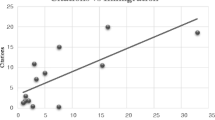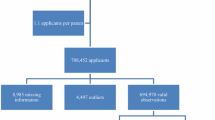Abstract
This paper explores the existence of technological spillovers coming from FDI in less developed host countries. Our results are based on a direct measure of technological flows across firms: patent citations. We find evidence supporting the idea that FDI exerts positive technological spillovers in the host country, although the results suggest that it may take about 8–9 years for these spillovers to occur. In addition, our results suggest that these spillovers are not homogeneous across all countries in the sample. While we find positive spillovers in South East Asian economies, this turns out not to be the case for South American economies.
Similar content being viewed by others
Notes
In the following sections, we will discuss the advantages and disadvantages of this approach when measuring the transfer of knowledge between firms.
One exception is the work of Jaffe and Hu (2003) in which the authors explore the potential technology diffusion of US and Japanese multinational firms to South Korea and Taiwan.
Although the experience of convergence towards the developed economies started earlier for the case of Japan, Japan has been considered as the main example of the flying-geese model (i.e. developing a competitive advantage through technology transfer made by hosting multinational firms). Hence, Japan is included in the sample. The exclusion of Japan from the sample, however, does not alter significantly our estimations. These results are available upon request.
More recently, Mancusi (2008) using patent citations, finds the existence of knowledge flows from technological leader countries to follower countries although the absorptive capacity of the host country matters for these spillovers to materialize.
Our exercise is using country year level data and to the best of our knowledge, there is no annual data for stock measures of human capital, which it would be the desirable measure of human capital to include. Given the importance of human capital in the effect of FDI in cross-country growth regressions, it would be desirable to include this variable to test the absorptive capacity hypothesis. However, the most widely used data set in the growth literature, the Barro and Lee (1994) data set, provides 5 year average measures on the proportion of the labour force that has obtained up to a certain level of educational attachment and the average years of schooling, the standard measure used in cross-country growth regressions. Since it is a 5 year average, by including explicitly this variable in our analysis we may not be able to capture well the effect of human capital in our regressions.
The results regarding the effects of FDI are not altered when we add the international trade variable in the rest of the specifications, which consider alternative lags. We have also run the specifications that include the variable FDI alone and we obtain the same results regarding the significance of the variable FDI and with coefficients of similar magnitude to those specifications in which we include also trade as a control variable. These results are available upon request.
In addition, note that the variable fdilag3 is not significant across all specifications. This variable becomes significant only when we consider the joint inclusion of the lags.
References
Aitken, B., & Harrison, A. E. (1999). Do domestic firms benefit from foreign direct investment? American Economic Review, 89(3), 605–618.
Alfaro, L. (2017). Gains from foreign direct investment: Macro and micro approaches. World Bank Economic Review Volume 30, Issue Supplement_1 Published: March 2017, pp. 2–15.
Alfaro, L., Chanda, A., Kalemli-Ozcan, S., & Sayek, S. (2004). FDI and economic growth: The role of local financial markets. Journal of International Economics, 64(1), 89–112.
Amsden, A. H. (1991). Diffusion of development: The late-industrializing model and Greater East Asia. American Economic Review, 81(2), 282–286.
Barro, R. J., & Lee, J.-W. (1994). Sources of economic growth. In Carnegie-Rochester conference series on public policy (Vol. 40, No. 1, pp. 1–46). Elsevier.
Borenzstein, E., DE Gregorio, J., & Lee, J. W. (1998). How does foreign direct investment affect economic growth? Journal of International Economics, 45, 115–135.
Botazzi, L., & Peri, G. (2005). Innovation and spillovers in regions: Evidence from European patent data. European Economic Review, 47(4), 687–710.
Branstetter, L. (2006). Is foreign direct investment a channel of knowledge spillovers? Evidenced from Japan’s FDI in the United States. Journal of International Economics, 68, 325–344.
Castellani, D., & Zanfei, A. (2003). Technology gaps, absorptive capacity and the impact of inward investments on productivity of European firms. Economics of Innovation and New Technology, 12(6), 55–576.
Coe, D. T., & Helpman, E. (1995). International R&D spillovers. European Economic Review, 39(5), 859–887.
Criscuolo, P. (2003). Reverse technology transfer: A patent citation analysis of the European chemical and pharmaceutical sectors. Mimeo.
Djankov, S., & Hoekman, B. (2000). Foreign investment and productivity growth in Czech Enterprises. World Bank Economic Review, 14(1), 49–64.
Gorg, H., & Greenaway, D. (2004). Much ado about nothing? Do domestic firms really benefit from foreign direct investment? World Bank Research Observer, 19(2), 171–197.
Haddad, M., & Harrison, Ann E. (1993). Are these positive spillovers derived from direct foreign investment? Evidence from panel data for Morocco. Journal of Development Economics, 42, 51–74.
Jaffe, A., & Hu, A. (2003). Patent citations and international knowledge flow: The cases of Korea and Taiwan. International Journal of Industrial Organization, 21(6), 849–880.
Jaffe, A. B., Trajtenberg, M., & Henderson, R. (1993). Geographic localization of knowledge spillovers as evidenced by patent citations. The Quarterly Journal of Economics, 108(3), 577–598.
Jaffe, A., Trajtemberg, M., & Fogarty, M. (2000). Knowledge spillovers and patent citations: Evidence from a survey of inventors. American Economic Review Papers and Proceedings, 90(2), 215–218.
Katayama, H., Lu, S., & Tybout, J. (2003). Why plant-level productivity studies are often misleading, and an alternative approach to interference. NBER Working Papers 9617, National Bureau of Economic Research, Inc.
Krugman, P. (2015). International economics (10th ed.). London: Pearson.
Mancusi, M. L. (2008). International spillovers and absorptive capacity: A cross-country cross-sector analysis based on patents and citations. Journal of International Economics, 76(2), 155–165.
Markusen, J. R. (1995). The boundaries of multinational enterprises and the theory of international trade. Journal of Economic Perspectives, 9(2), 169–189.
MC Garvie, M. (2005). The determinants of international knowledge diffusion as measured by patent citations. Economics Letters, 87(1), 121–126.
Peri, G. (2006). Determinants of knowledge flows and their effect on innovation. The Review of Economics and Statistics, 87(2), 308–322.
UNCTAD. (2012). World investment report: Towards a new set of investment policies.
Veugelers, H., & Cassiman, B. (2004). Foreign subsidiaries as a channel of international technology diffusion: Some direct firm level evidence from Belgium. European Economic Review, 48(2), 455–476.
Xu, B. (2000). Multinational enterprises, technology diffusion and host country productivity growth. Journal of Development Economics, 62, 477–493.
Author information
Authors and Affiliations
Corresponding author
Additional information
Publisher's Note
Springer Nature remains neutral with regard to jurisdictional claims in published maps and institutional affiliations.
Rights and permissions
About this article
Cite this article
Navas, A. Does FDI generate technological spillovers in the host country? Evidence from patent citations. Econ Polit 36, 399–414 (2019). https://doi.org/10.1007/s40888-019-00146-8
Received:
Accepted:
Published:
Issue Date:
DOI: https://doi.org/10.1007/s40888-019-00146-8




